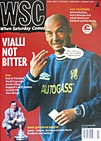 Keith Butterick took on the job of persuading Halifax to keep a football club and invest in its shabby ground. Here's how he got on
Keith Butterick took on the job of persuading Halifax to keep a football club and invest in its shabby ground. Here's how he got on
You have always needed a sense of humour and irony to be a Halifax Town fan. The club is currently on the verge of having one of the finest grounds in the lower divisions and has never been so rich, the recent windfall of some £700,000 after Fulham sold Geoff Horsfield adding to already swollen coffers. Yet we are languishing at the bottom of the League and, at the time of writing, looking for a manager
Was it all a dream? Was all the euphoria after we won promotion from the Conference, then topped the Third Division with crowds of 5,000 plus, simply an illusion? I believe not. The current problems are short-term and the future should be bright because the club has finally tackled what has been its biggest albatross and hindrance to development, the ground.
Those who may not have visited The Shay for five years or so would be amazed at the transformation. Having been quite probably the worst ground in the country (immortalised in an episode of Frost, which used it as the ground for Denton United), The Shay now looks and sounds like a football stadium .
The wide open spaces, the disused speedway track and the terraces that could not be stood on used to ⌦make watching football there a distant, empty experience. No matter how large the crowd, it never seemed to make enough noise to affect the players. One of the most successful managers in the club’s history, George Kirby, actually wanted to broadcast recordings of a Wembley crowd over the tannoy to improve the atmosphere.
Because of the geography of Calderdale, however, we are stuck with The Shay. Unlike the vast majority of football grounds, it is situated in a relatively affluent part of the town. Just over the road, developers are building £100,000 houses and eye the stadium enviously as a potential site. There have been a few chairmen in the club’s recent history who have also been suspected of wanting to sell the ground for redevelopment.
However, those with the club’s best interests at heart have also been unable to cash in on an asset worth millions: first, because a previous administration in desperate financial straits sold the ground to the local council for a fraction of its worth; and second, even if it was sold, finding 14 acres of flat land in the hills around the town for a new ground is next to impossible. I know, because I tried.
Five years ago, Halifax Town were on the brink of extinction. The club’s biggest creditor was Calderdale Council, which was also cash-strapped, and its biggest asset was The Shay. The council had an offer on the table from Asda to build a supermarket at The Shay for £8 million. It would have been a nice, neat solution for the council if the club had died and the ground had been sold.
As a councillor at the time, with a family involvement going right back to the club’s formation, my brief was simple: save Halifax Town. That was difficult, because its previous management had reneged on agreements and there were always suspicions that certain directors of the club were only interested in its property value.
Supporters, however, rallied round and raised over £50,000 for the club’s immediate creditors, while a behind-the-scenes battle was fought and won with other councillors to retain The Shay for sport. The chairman at the time, John Stockwell, was a supporter as well as a businessman and above all a man of integrity.
The other significant move came when the rugby league club in Halifax finally accepted the reality that its own ground at Thrum Hall was never going to be made acceptable for Super League – if it wanted to stay in the elite that could only be achieved by sharing at The Shay.
Some might say that the building of the ground has been done at the expense of the team, but the money for redevelopment has come from Football Trust sources and funds that the football and rugby clubs have found for the purpose.
The problems with the current team lie not in the ability of the players, but in a manager, Mark Lillis, who clearly was unable to get the best out of them. It might make us choke that Bradford survived in the Premier, Burnley got promoted and Leeds are in Europe, but Halifax fans must not give up hope when their biggest problem is so close to being resolved.
From WSC 165 November 2000. What was happening this month